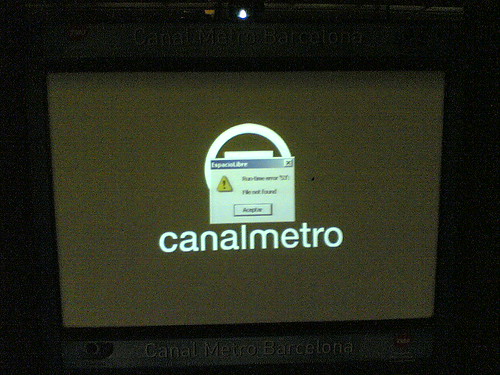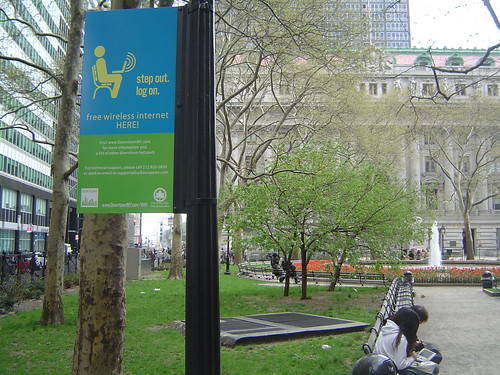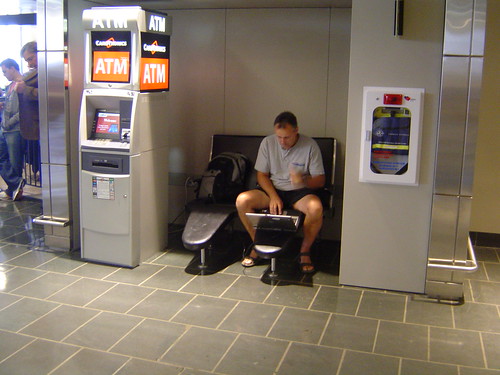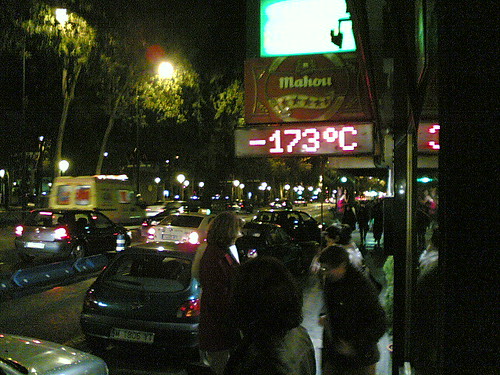Posted: April 29th, 2009 | No Comments »
A workshop on Hybrid Design Practices will take place at the upcoming Ubicomp conference. The focus is close to the interplay of methods I applied in my thesis, mixing design science research methods with qualitative and quantitative inquiries:
The focus of this workshop is on hybrid design practices, approaches that draw on techniques from various fields to create novel methods of inquiry. The aims of this workshop are, first, to bring together a multi-disciplinary group of practitioners and researchers to learn from one another’s expertise in choosing and evaluating methods of design practice, and, second, to discuss implications of the underlying methodologies and epistemologies upon which these techniques are built.
The goals of this workshop, then, are twofold; first, to open up a space for reflection on current approaches towards interdisciplinary research and design in Ubicomp, and second, to develop a new vocabulary, both practically and theoretically, for “making” interdisciplinary Ubicomp research, thus, marking the study of hybrid design practice as an area of community-wide inquiry.
Relation to my thesis: My thesis has an unsual aspect characterized by some sort of hybrid design practices that led to the production of “factual” knowledge (such as the urban flows shown in some of the papers) and “design” knowledge (such as the strategies for improving interaction). My thesis also contains methodological novelties when approaching human interactions with ubiquitous geoinformation, such as models and concepts related to implicit and explicit interactions. I believe this diversity that provides complementary sources of evidence, strengthen the support to the results presented
in the thesis (i.e. strengthening the approach through the diversity). This is rather non-standard, but it is hopefully a recognized attempt for for “making” interdisciplinary Ubicomp research.
Posted: April 28th, 2009 | 7 Comments »
It is entitled “Aspects of implicit and explicit human interactions with ubiquitous geographic information“. In this dissertation, I cover some implications of the presence of ubiquitous technologies that afford people new flexibility in conducting their daily activities and simultaneously provide the means to study human activities in time and space. I employ seven of my first-authored papers to describe the following aspects of people interactions with these technologies to access and generate ubiquitous geoinformation:
- Sources and perception of spatial uncertainty (CatchBob!)
- Appropriation of ubiquitous geoinformation (Taxi drivers in Barcelona)
- Implicit human interaction with wireless infrastructure as source of travel detection (Travel survey, no public content yet)
- User-generated ubiquitous geoinformatin as evidence of tourist dynamics (Tracing the visitor’s eye in Florence and Rome)
- Digital footprints as evidences of urban attractiveness (New York City Waterfalls)
At the start of this journey to a PhD, 3.5 years ago, I remember my wish to learn to fit to the mold of academia. Instead, I quite naturally emancipated from that thought, with inspirations from Nicolas or Julian. While keeping true to the purpose of science, I certainly intended to explore beyond the bounding box of one domain and its methods. Reading Järvinen Pertti’s book gave me that necessary holistic view on research methods. The exposure to new approaches and different research cultures and the consideration of real-life issues certainly contributed to the unusual aspect of my thesis. In fact, this thesis is the fruit of this exploration. I am convinced that the interdisciplinary knowledge and skills developed in this journey will enable me to adapt to a constantly changing world. Indeed, my work does not claim in-depth findings acquired through the application of one methodology. Rather, It stresses that varied approaches applied to varied problems strengthen both the methodological approach and the support for the more factual knowledge evidenced. To reach this contribution, I explored the creation of footbridges between domains that do not have the tradition to cross-communicate. I take pride to have developed both factual and designl knowledge from field works in collaboration with cognitive scientists, social scientists, software engineers, network engineers, computer scientists, industrial designers, and architects. The warm response of the members of my thesis jury constituted by experts from the domains of geography, anthropology, data mining, computer science, spatial information science and transportation research is certainly a proof of the attractiveness of my work in a wide context. It also confirms my wish, shared with my PhD advisor, to produce a scientifically honest piece of work that is accessible to people on the edges of academia.
In my next journey, I will further nurture my research qualities, on that edges, at the friction area between the technical, the human and the urban. But this time, I will practice freed from the overheads of academia (more on that later).
Relation to my thesis: Almost the end of the process… let’s prepare the defense! A collateral outcome of this journey, I now master a fourth language, Spanish.
Related to *sigh* DEA Thesis Submitted *sig* and Framing my PhD Dissertation
Posted: April 27th, 2009 | 1 Comment »
Related to my past project on Tracing the Visitor’s Eye and World’s Eyes, David Crandall and colleagues at Cornell have created global and city maps and identify popular snapping sites from photos uploaded on Flickr. They ran statistical analyses to identify the most important clusters of “”what the world is paying attention to”. Next they analysed the text tags added to photographs in those clusters, as well as key visual features from each image, to automatically find the world’s most interesting tourist sites. We find that visual and temporal features improve the ability to estimate the location of a photo, compared to using just textual features (slightly similar to IM2GPS: estimating geographic information from a single image). Their paper, Mapping the World’s Photos, recently presented at the WWW 2009 conference explains the process and results in more details.

Representative images for the top landmark in each of the top 20 European cities. All parts of the figure, including the representative images, textual labels, and even the map itself were produced automatically from our corpus of geo-tagged photos. Image courtesy of David Crandall. More on the project’s web page.
Relation to my thesis: Similar to my work, Crandall et al. I have used the spatial distribution of where people take photos to define a relation between the photos that are taken at popular places. I have used similar representations of spatio-temporal traces to illustrate my techniques and finding. However, my motivations has not been to improve photo management and organization applications (see also Mor Namaan’s work). Similar to Currid and Williams’ work on Mapping the Cultural Buzz, I employed georeferenced photos as a proxy to “qualify” the space (e.g. its attractiveness). But rather than mapping and qualifying a timeless space (Currid and Williams talk about “buzz-worthy” without referring to when), I particularly explore the temporal aspect of the data (see The End of Timelessness). For instance, in my work on the NYC Waterfalls, I studies the evolution of the density of georeferenced photos and the flows of photographers to provide evidences of the evolution of the attractiveness of the space (journal paper still in submission).
The Visualization of photographer movement in Manhattan mapped by Crandall is particularly stiking:

To produce these figures, we plotted the geolocated coordinates of sequences of images taken by the same user, sorted by time, for which consecutive photos were no more than 30 minutes apart. Image courtesy of David Crandall
Posted: April 13th, 2009 | No Comments »
Martin Dodge announces the Software and Space theme issue for Environment and Planning A with some of the papers available online now. This issues was meant as a useful contemporary review of different developments under what can be labelled, broadly, as ‘the spatiality of ubiquitous computing’ (see the introduction “How Does Software Make Space? Exploring Some Geographical Dimensions of Pervasive Computing and Software Studies“). Through the lenses of Software studies that expands understanding of code beyond its technical aspects, this issue brings geographical work on ubiquitous computing. In other words, it discusses the significance of software as an agent in the making of spaces. For instance, software can make space through the capacity of calculation at a scale and speed far beyond human abilities. Equally significant for geographers is the degree to which software is also spatial; an issue that will become only more important as ubiquitous computing unfolds in the social world. For instance the appearance of “machine readable” spaces:
The growing calculative role of code is of greatest concern with its ability to render all kinds of spaces ‘machine readable’ through identification technologies and fine scale sensors (Dodge and Kitchin, 2005a; Dennis 2008) enabling the generation of ‘data shadows’ and so-called ‘lifelogs’ that record the minutiae of everyday life with great granularity and, potentially, to never forget what has been captured (Allen 2008; Dodge and Kitchin, 2007). These extensive and readable spaces can then be interpreted by code which makes decisions automatically including socially significant ones, in terms of access control and anticipatory governance (cf. Adey 2009; Graham, 2005).

An agent in making Manhattan readable
Close to my observations, the editors Martin Dodge, Rob Kitchin and Matt Zook highlight the particularities of software in relation to their failures and fluctuating quality:
As a product software also enjoys some unusual qualities. How software is licensed means that liabilities for its failures are limited. Although most people do not read the terms and conditions they agree to when using licensed software, they are willingly accepting an imperfect product whilst abrogating the supplier from responsibility for damage caused. These imperfections in terms of bugs, glitches and crashes are at once notorious and yet also largely accepted as a routine part of the ‘conveniences’ of computers.

Runtime error in the subway, a routine part of the ‘conveniences’ of computers. Contact your service representative?
Relation to my thesis: After considering the temporal dimension of ubiquitous computing, I use the contributions of my thesis to discuss the aspects of human-space relationships, particularly with the evidences that the integration of ubiquitious geoinformation changes the relations of people with the space. This issue echoes very well with my works that show how software that collect, store, analyze and visualize ubiquitous geoinformation alters the perception of the space, particularly to what the editors describe as “Machine readable spaces” and “Imperfections as the routine part of the convenience of computers”. It complements some of my consideration on the temporal dimension of ubiquitous computing
Posted: April 11th, 2009 | No Comments »
Writing the conclusion of my dissertation, there is one implication of my research work that I still have not completely gotten my brain around. I will try to layout my thoughts here. I believe that one contribution of my work has been to reveal the new aspects of time with our relation to space through ubiquitous technologies. For instance, I have studied the co-evolution of a community of early adopters with their navigation system, the timely capture of travelers experiences, the potentials of spatio-temporal data shadows such as measuring the evolution of the attractiveness of the space. Each study shows that our relation with geoinformation (and by extension space) has been altered from our interactions with mobile and wireless technologies. The information is accessible and generated ubiquitously, augmenting our roles of sensors and actors of the space. This presence of what Adam Greenfield would refer to, in a more articulate manner, as the Big Now creates an utilitarian fascination to the real-time or the predictability as instantiated in my case study on “Detecting air travel in real time” from a mobile phone implicit interaction wireless networks (in submission). This fascination overshadows the end of our ephemeral relation with space potentially leading to a new version of the Internet Archive’s Wayback Machine and the presence of the hard/soft infrastructure design that does not take it into account.
I call it the end of timelessness. The end of the ephemeral, or what Adam Greenfield would describe as the Long Here, is mainly exposed in my work on Tracing the Visitor’s Eye and related. The observations of the presence of the hard infrastructures that deny the Long Here took place around the NYC Waterfalls study and the novel opportunity to define of indicators of the evolution of attractiveness of the space. Similarly, the ubiquitous technologies of the present, fail to accommodate for the Long Here, the change in the city and the implication on the social practices. Wearing qualitative lenses with a taxi drivers in Barcelona, I could observe co-evolutive ballet with their navigation system and extract the implications of the soft infrastructure on the knowledge of the city.
The embedment of urban informatics into the urban fabrics makes the integration of the Long Here in integral part of the design of hard and soft infrastructures. I would argue that this kind of case studies sets stage to the end of the timelessness considerations of individuals interactions with urban infrastructures. A satellite navigation system does not perform the same service the first six months in the practices of a inexperienced taxi drivers compared to a user with 20 year of knowledge of the city. Moreover, they do not, over time, request the same granularity of geoinformation nor do they assess the quality of the information with the same experience of the technology and knowledge of the city. A different kind of “long here” evolution of the presence and practices of that can be analyzed through their interactions with soft infrastructures to assess the quality of the spatial settings. This longitudinal understanding of the evolution of the interaction can then be applied to the design of the urban informatics. For instance, we made sure that our mobile phone algorithm to detect air travel was not perfect, as our system takes advantage of false detections to keep the survey participants with a certain level of involvement.
The evolution of the people practices, interactions and frictions with the urban space can be compiled very informally as Nicolas and I compiled in Sliding Friction and related. This kind of approach helps highlighting the reality, its complex dynamics, its subtleties, and its situational particularities. My research work suggests the combinations of more formal data collection and analysis approaches. They took the form of quantitative (reality mining), qualitative (ethno-inspired), mixed research methods to a more active, utility-driven mode with design science research.

New use of Bowling Green, the oldest public park in New York City
Now these approaches strongly contrast with the practice of architecture and urban design that almost utterly ignore this notion of time. For instance, from my understanding, there exist limited methods to capture and evaluate the user experience and the use of the built space. That makes me wonder wether since Stewart Brand’s How Buildings Learn (video of the BBC TV series inspired by the book) any progress has been made to integrate the complexifying intertwinement of hard infrastructures, soft infrastructures and individual/social practices into their design practices. 15 years ago, Frank Duffy explained that “architects have been slow to join the evaluation bandwagon, It’s got somewhat trapped in the academic field, I am afraid“. When considering the hybrid space with real-time elements, asynchronous communications and its logging capabilities of soft infrastrcture, it seems that the human/social elements with their evolution and adaptability find little consideration when in competition with aesthetic.

A bench to relax or work or both? between an ATM and a defibrillator at the cramped part of Logan airport
In consequence, as Steward Brand explains, “More often than not, the pull to conduct evaluations has come from client organizations, not from the architects themselves” also suggesting to collect feedback from facility manager to grasp the dimensions of time and use into building. In contrast, in the digital world, there is a greater tradition of analysing breadcrums to improve the design of web sites. Of course, nowadays, who and where are the facility managers in hybrid spaces?
The lack of consideration of the human in current practices of the designer of the hard infrastructures is particularly striking with the traditional aseptic graphics and medium to communicate them. But the competences to learn from the evolution of the infrastructure do not only require interpretative methods for human and social dynamics, but also for technological/intrastructural counterparts. For instance, 4 years ago, the analysis the players space-time trails in our pervasive game CatchBob! with a custom made “replay tool” necessitated technical knowledge to extract the technological issues of the ubiquitious infrastructures and its evolution. I would not expect this to be otherwise nowadays. This to exemplify that the ability to understand and properly bend the hard infrastructure will naturally come from cross-disciplinary teams that consider time in their practice. For instance, software engineering has been evolving in its practice to check the quality assurance throughout the life of a software (see Software that makes software better). The techniques aim at preventing from the software to break without running it (statistic analysis tools) and also detect when it breaks (dynamic analysis tools).

Consequence of unproper blackbox testing… Maybe an error caused by a 64 bit floating point number relating to the outdoor temperature respect to the wind conditions converted to a 16 bit signed integer
Relation to my thesis: Extract some contribution of my PhD thesis (the end of timelessness) to consider their implications on the evaluation of the evolution of the relation between the hard, the soft and the human in hybrid environments. From my experience, a mix of methods are necessary to grasp a world of fast-moving technology. This methods go beyond the current limited approaches of practitioners of the built space, to the exception of Post-occupency evaluations that introduce the dimensions of time and use into building. On the other hand, the practices of practitioners of the soft and digital world are evolving to take time and evolution into consideration. Of course that should lead to an improvement in: reliability, life-cycle behavior, environmental impact and user acceptance.
My research work sets the stage for tools and techniques to reveal evolution or repetitions, with observations and measures of expectation, initial frustration and delight, adjustment, and long-term adaptivity. I examply some elements in my taxi drivers study, the application of metrics as in new york and the collection of evidences “sliding frictions”.
Posted: April 8th, 2009 | 1 Comment »
A couple of weeks ago at the Association of American Geographers meeting in Las Vegas, Elizabeth Currid (USC) and Sarah Williams (Columbia University) presented their paper The Geography of Buzz: Art, Culture and the Social Milieu (full aper). As described in Mapping the Cultural Buzz: How Cool Is That?, their work takes snapshots from more than 6,000 events from the data mining of 300,000 photos from Getty Images to categorize them according to event type, controlled for overly celebrity-driven occasions and geo-tagged at the street level. They exploited these photos as proxy for ‘buzz-worthy’ social contexts. As a result, they were able to quantify and understand, visually and spatially, how this creative cultural scene really worked. Based on these evidences, they can argue that those not conventionally involved in city development (paparazzi, marketers, media) have unintentionally played a significant role in the establishment of buzz and desirability hubs within a city.

Density of “fashion” events in New York
Relation to my thesis: After Anthony Townsend’s Augmenting Public Space and Authoring Public Art: The Role of Locative Media, the geography of buzz provides another instantiation of the value of digital footprints to describe the city. However, this use of photos as proxy of human time-space activity raises issues in not to confound behaviors with endorsement. It is one of the limitation of my work on the NYC Waterfalls. Nevertheless, Currid and Williams work certainly strengthen the value of my work on Tracing the Visitor’s Eye, with quotes that could come from straight out of this blog:
“We’re going to see more research that’s using these types of finer-grained data sets, what I call data shadows, the traces that we leave behind as we go through the city,” she said. “They’re going to be important in uncovering what makes cities so dynamic.”
They also provide another argument for the discussion of the contributions of my research work in the context of human-space relationship:
“People talk about the end of place and how everything is really digital. In fact, buzz is created in places, and this data tells us how this happens.”
Finally, an excellent reference in their bibliography that coins data shadows:
Zook, Matthew, Martin Dodge, Yuko Aoyama, Anthony Townsend, “New Digital Geographies: Information, Communication, and Place”, In Geography and Technology, Kluwer Academic Publishers, 2004
Posted: April 8th, 2009 | No Comments »
Data mining artist Andrea Vaccari gave a thorough interview to ZDNet on his current investigation at MIT SENSEable City Lab also providing context of the lab’s current endeavors. He starts of by argumenting on the necessity to produce quality visualizations responding to the skeptics that call it “info-porn“. I found myself defending the necessity of the urban demos produced at SENSEable to attract attention, stimulate the dialogue and stretch the imagination. Yet, this is only the tip of the iceberg of the work produced in Cambridge that strongly relies on the experience and data generated during the demos to produce scientific content. The opacity of the research review process and publication venues, does not often allow to get a glimpse of the research outcomes. So Andrea goes at it and gets specific on the type of contributions we can expect form the analysis of city-scale data. He takes example of the project in the context of the New York City Waterfalls we collaborated on to describe how the analysis of urban dynamics can become evidences of the evolution of the attractiveness of the most popular areas of a city. Other of his works aim at identifying unexpected events and assist public authorities and first responders.
Andrea recently presented the lab’s work at Etech (slides) where is seems that the buzz was on the fusion of sensor data with social data traffic that “to improve life“. Beside this honorable goal, I am dubious that this is purely reachable with data mining, machine learning to networks analysis and statistics. But maybe the current conclusion of my dissertation plays a bad influence on me.
Relation to my thesis: Andrea describes very well the lab its approach and projects I had the chance to share back in my SENSEable days. The open question that he leaves at the end of his interview are up my alley. Currently writing the conclusion of my dissertation, I take advantage to draw the implications of my work and discuss “human side of urban data” and what it means in context of urbanism; discarding a pure data-driven urbanism and sketching something I would call human-based urbanism, an approach mixing quantitative and qualitative data analysis.









